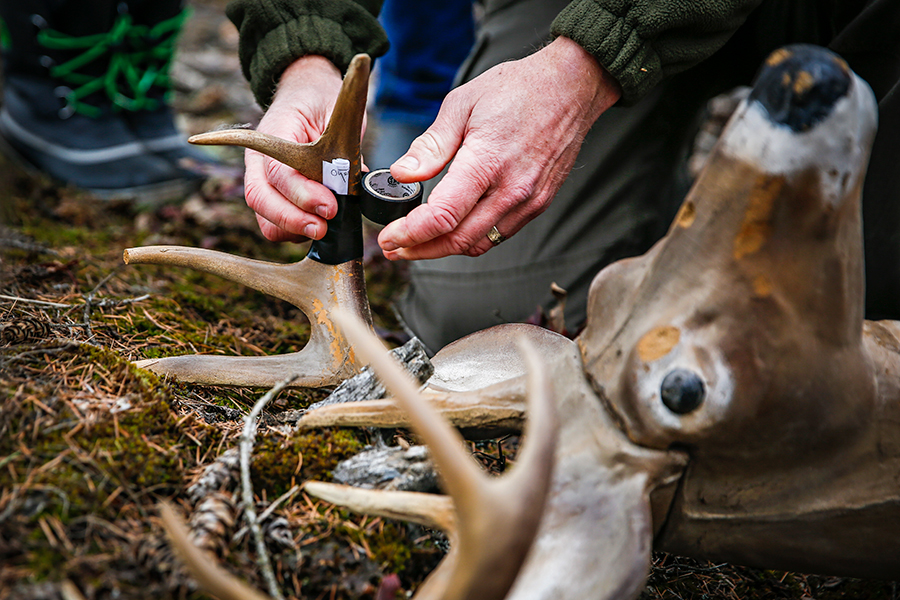2024 Big Game Hunting Forecast
With spring surveys showing healthy white-tailed deer and elk populations, wildlife managers say the prospects for bagging big game in northwest Montana are the best they’ve been in years. General rifle season begins Oct. 26.
By Tristan Scott
The arrival of autumn marks the beginning of big game hunting season in northwest Montana, a beloved time of year for the thousands of residents who partake in the rich tradition.
Although the general season for deer and elk doesn’t open until Oct. 26, the archery season for most big game opened on Sept. 7 and the general rifle season for black bears and wolves begins Sept. 15. Montana boasts one of the longest hunting seasons in the U.S., and northwest Montana has the second largest tract of public land in the state — 6.2 million acres — and hosts a diverse suite of free-ranging wildlife, including deer, elk, bears, wolves, mountain lions, and furbearers.
Four big game check stations will be open in Region 1 on weekends during the general season: U.S. Highway 2 west of Kalispell, Montana Highway 83 north of Swan Lake, Montana Highway 200 on the west end of Thompson Falls, and U.S. Highway 93 near Olney. Hunters are required to stop at game check stations.
So, what should hunters expect as they prepare to head afield?
“Big game survival in northwest Montana was good last winter with good recruitment in elk and deer,” according to the 2024 Big Game Hunting Forecast for Montana Fish, Wildlife and Parks’ (FWP) Region 1. “Snow conditions were mild and other than a brief cold snap, temperatures were generally mild as well.”
Elk
Those mild winter conditions were particularly beneficial for elk calves that wildlife biologists observed in northwest Montana during their 2024 spring surveys, which recorded 48 calves per 100 cows in Hunting District 121 between Thompson Falls and Noxon for “the highest level of recruitment observed in this hunting district in more than 30 years.”
Recruitment in other districts is expected to be higher than normal as well, according to agency officials, who predicted that elk numbers would be slightly higher across the region. Elk hunting is challenging in northwest Montana due to difficult terrain, heavily forested habitat, and wildlife population densities relatively lower than other areas in Montana.

White-tailed deer
White-tailed deer numbers should also be on the increase this year due to a mild winter in Region 1, where biologists observed between 34 and 54 white-tailed deer fawns per 100 adults during spring surveys across all hunting districts.
“The number of fawns to survive the winter was the highest we have seen in years,” the forecast states.
Hunters should see an increase in young bucks in the field , the report states, with the number of older-aged bucks on par with last season. For more information on white-tailed deer numbers and harvest, see the Region 1 2023 Annual Report at fwp.mt.gov/aboutfwp/regions/region1.

New this year is the mandatory Chronic Wasting Disease (CWD) testing of deer harvested within the Libby CWD Management Zone. Hunters with a white-tailed deer B license (199-20) can only hunt in the Libby CWD Management Zone and are required to have deer tested for CWD within 10 days of harvest.
Mule deer
The mild winter contributed to a high survival of mule deer fawns across the region as well.
“We expect stable to slightly increasing populations in much of the region, with larger numbers of yearling bucks observed,” the forecast states. The number of older-age bucks should be similar to last year. Antlered bucks (characterized as deer with an antler or antlers at least 4 inches long as measured from the top of the skull) may be harvested in Region 1. No antlerless harvest opportunity exists in the region. The North Fisher area in Hunting District 103 requires a permit to hunt mule deer (HD 103-50), and, also new this year, CWD testing is required for any deer harvested with this permit. More information on the status of mule deer in Region 1 can be found here: fwp.mt.gov/aboutfwp/regions/region1.
Moose
Results from a 10-year study on moose indicated that the Cabinet-Salish population wintering south of Libby appears to be stable to slightly increasing. Overall numbers are below historic highs, and the moose population looks to have stabilized at the current level. Similar trends in moose populations likely exist in most of Region 1.
Visit fwp.mt.gov/conservation/wildlife-management/moose for more information.

Chronic Wasting Disease (CWD)
CWD has been detected in white-tailed deer, mule deer and moose in the Libby area. Hunters need to be aware of the Libby CWD Management Zone and its boundaries, which include portions of Hunting Districts 100, 103 and 104. CWD has been found in a few cases outside the management zone, and it is recommended that hunters have their deer, elk and moose tested.
Agency officials encouraged hunters to submit samples for testing so FWP can better assess the status of CWD in northwest Montana. Hunters who want to have harvested deer, elk and moose tested can submit samples themselves, visit the Libby CWD sampling station (located on U.S. Highway 2 at mile marker 35) during the general season (Saturdays through Tuesdays), or stop by the Region 1 headquarters in Kalispell (located at 490 North Meridian) during business hours, Monday through Friday. The ability of FWP staff to collect samples at game check stations will be limited and “will occur only if it can be done safely and check stations are not busy.”
For more information, visit fwp.mt.gov/conservation/chronic-wasting-disease.